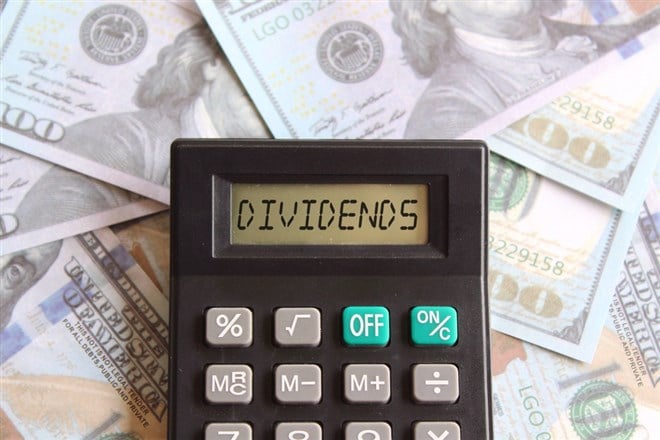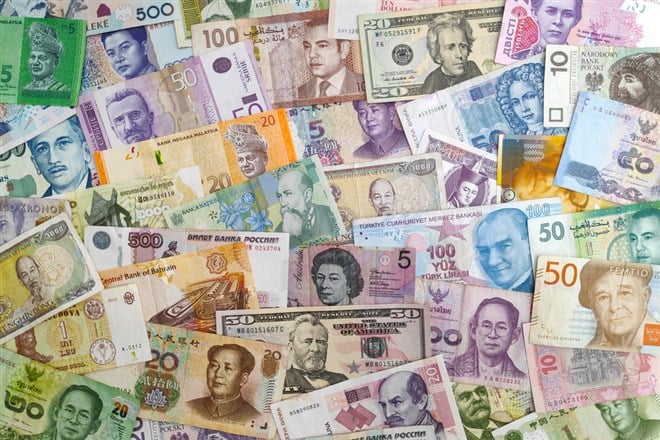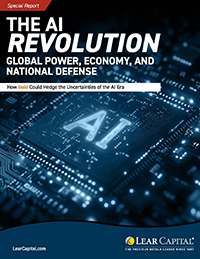Ticker Reports for June 24th
3 Industrial Leaders Boosting Dividends as the Sector Outperforms
Two leaders in the industrials sector just significantly increased their dividends, while another behemoth is very likely gearing up to do the same. The industrial sector has been resilient so far in 2025, even as the returns of the general market have been disappointing.
As of the June 20 close, the S&P 500 industrials sector is the best-performing among all 11 in index tracks. S&P 500 Industrials performance is most easily tracked using the Industrial Select Sector SPDR Fund (NYSEARCA: XLI). The fund has provided an approximate total return of 8.4% on the year, outpacing the second-best performing sector, utilities, by around 1%. Meanwhile, the S&P 500 as a whole has a total return of less than 2%.
Adding to the good news within the sector is the fact that some of its most important names have already raised their dividends or clearly plan to raise them. Below are these three names.
They are all considered leaders in industrials and in the specific parts of the industrials sector they serve. All market cap, return, and dividend yield figures use data as of the June 20 close.
DAL: The Biggest Name in Airlines Lifts Dividend by 25%
First up is Delta Air Lines (NYSE: DAL). The company clearly stands out as a leader in its part of the economy. Delta is the world’s most valuable stock in the passenger airlines industry, with a market capitalization of approximately $31 billion. On June 19, Delta announced a very sizable increase to its quarterly dividend of 25%.
The company will pay its next $0.1875 per share dividend on Aug. 21 to shareholders of record as of the close of business on July 31. This next quarterly dividend equates to an annual payout of $0.75 per share. This gives Delta shares an indicated dividend yield of nearly 1.6%.
Among the six U.S. passenger airline stocks with market capitalizations over $5 billion, Delta is one of only two that pay dividends. Another interesting detail about Delta is that Wall Street analysts appear notably bullish on the stock. The MarketBeat-tracked consensus price target of just under $62 implies over 30% upside in shares.
CAT: Machinery Mammoth Extends Dividend Increase Streak to 31 Years
Next up is the approximately $170 billion industrials stock Caterpillar (NYSE: CAT). The firm is the most valuable U.S. stock in the machinery industry.
On June 11, Caterpillar raised its quarterly dividend by 7% to $1.51 per share. This next dividend will be payable on Aug. 20 to shareholders of record at the close of business on July 21. The company notes that this marks 31 years in a row in which it has increased its dividend.
Overall, the expected annual dividend payment of $6.04 gives the stock an indicated dividend yield of just under 1.7%. This yield is essentially in the middle of the pack among U.S. large-cap stocks in the machinery industry.
Yields within this group currently reach around 5%, exemplified by Stanley Black & Decker (NYSE: SWK).
Airbus’s Payout Range Increase Foreshadows Dividend Boosts to Come
Airbus Group (OTCMKTS: EADSY) takes the final spot. The company's leadership position is evident as it is one of the world’s five largest stocks in the aerospace and defense industry. Airbus is also known for being part of the essential duopoly when it comes to commercial aircraft manufacturing, along with Boeing (NYSE: BA). Officially, Airbus has not recently declared an increase in its dividend. However, a June 18 business update strongly suggests that increases are on their way.
Companies often decide how large a dividend they will pay by setting a payout ratio range. The payout ratio describes what percentage of a company’s earnings it will pay out as dividends. The company’s previous payout ratio range was 30% to 40%. Now, the firm is raising the upper end of that range to 50%.
This means that the percentage of its earnings it pays out as dividends is likely to rise. Analysts also see the company’s earnings per share growing significantly over the coming years. These two factors set up a likely scenario in which the company’s dividend will increase, possibly by a very significant amount. Currently, Airbus has a dividend yield of approximately 1.4%.
Overall, the steps these companies are taking to increase their capital returns are strong news for current or potential shareholders. Notably, the yield of all these names is higher than the approximately 1.2% yield offered by the S&P 500 Index.
Recession Ahead — Even Trump Can't Stop It
Recession Ahead — Even Trump Can't Stop It
3 International Bank Stocks With Strong Dividends
The U.S. stock market stumbled near all-time highs last week, prompting investors to review the landscape. With conflicts brewing overseas and economic data beginning to weaken, it might be time to once again focus on income over capital appreciation.
One area with both strong growth prospects and dividends is the international banking sector, and today we’ll look at three international bank stocks that could help preserve capital if market conditions break down.
The End of U.S. Exceptionalism?
Since the end of the Great Financial Crisis, U.S. investors have gained an edge by simply having a strong domestic bias. Whether it was the Flash Crash in 2011, the 2018 bear market, or the COVID-19 crash in 2020, investors have been rewarded by staying the course and buying the dip. Retail dip buyers were rewarded earlier this year when President Trump announced, and then quickly backed off his reciprocal tariff plan.
However, the notion that there is no alternative to U.S. stocks has taken a few gut punches over the last few years. Since the 2022 bear market ended, U.S. stocks have been on a tear, but European stocks have performed even better. And since the start of 2025, the S&P 500 has been one of the worst-performing indices in the developed world.
What’s causing this shift in investment attitudes? It may be premature to announce the end of American exceptionalism, but here are three commonly cited reasons investors are expanding their market horizon.
- Differing Macro Environments: Last week, the Federal Reserve left the overnight rate unchanged, and the market is predicting only two rate cuts for the rest of the year (likely in September and December). The Fed cited rising inflation expectations and a resilient labor market as reasons for maintaining its target range of 4.25% to 4.50%. But while the Fed is standing pat, the European Central Bank is well into its cutting cycle and dropped its benchmark rate to 2.25% in April. Sticky inflation and declining GDP could stifle growth in the U.S. just as stimulative monetary policy sweeps through Europe, Asia, and other North American countries.
- The USD Is No Longer a Safe Haven: Something unusual occurred when markets plummeted following the Liberation Day tariff announcement. Gold prices and bond yields spiked as the flight to safety began, but the dollar didn’t follow suit. USD depreciating at a time of uncertainty was eye-opening, implying that perhaps the dollar isn’t the safe-haven asset it once was. A depreciating dollar is also bullish for international banks with foreign currency revenue, as it acts as a multiplier on earnings not denominated in USD.
- Attractive Valuations: Now that international fiscal and monetary tailwinds are in place, investors may take note of international valuations compared to those of U.S. peers. The S&P 500 currently trades around 23 times 2025 earnings, higher than the mid-teen rates seen in Europe, Canada, and the U.K. If the U.S. macro environment deteriorates, investors will have little reason to pay up for American equities.
Three International Banks That Can Benefit From Changing Global Economic Attitudes
When the tide shifts, good investors adjust their sails. International stocks have outperformed their U.S. counterparts for several years, and foreign banks are well-positioned to reap the benefits of a depreciating dollar. These three bank stocks outside the U.S. offer growth potential and stable dividends.
Royal Bank of Canada: Bundling Growth and Stability
- Dividend Yield: 3.23%
- Dividend Payout Ratio: 45.67%
Royal Bank of Canada (NYSE: RY) missed top and bottom line projections in Q1 2025, but reported EPS growth of 42% year-over-year (YOY) and record net income of $5.1 billion.
One driver of the bank’s growth was the acquisition of HSBC Bank Canada, which netted the firm an additional $214 million in the quarter.
Canada’s rate environment and GDP projections could increase lending demand, and RY is trading near all-time highs as a result.
The dividend is also sturdy, as RY has raised payouts for 15 straight years.
Banco Santander: Understanding the Assignment in the Digital Age
- Dividend Yield: 2.22%
- Dividend Payout Ratio: 20.69%
Banco Santander S.A. (NYSE: SAN) also reported record profits in Q1 2025, growing income 19% YOY and EPS 26% YOY. While the bank has an emerging presence in the U.S., its primary markets are Spain, the U.K., Portugal, and Poland- four nations with strong growth prospects and moderating inflation.
Santander’s net margins are approaching an eye-popping 17%, but the stock still trades at just 9.7 times forward earnings and 1.8 times sales. The bank is also embracing the digital age, seeking to integrate the brick-and-mortar model with the new wave of online-only banks.
Digital sales increased by 23% YOY in the most recent quarter, so the initiatives are already paying dividends. Additionally, the 20.69% dividend payout ratio (DPR) on the actual dividend suggests ample room for future payout increases.
NatWest Group: Initiatives for Market Share Gains in the U.K.
- Dividend Yield: 5.63%
- Dividend Payout Ratio: 51.68%
NatWest Group plc (NYSE: NWG) is also making strategic acquisitions to expand its market share.
The U.K.-based bank recently acquired Sainsbury’s Bank, which adds over one million new customers and 2.7 billion euros (approximately $3.1 million) in new savings.
NatWest also has an agreement with OpenAI to remake its customer service modules in an attempt to improve efficiency and reduce costs.
The bank’s Q1 2025 earnings release was a significant beat on both top and bottom lines, with income increasing by nearly 16% YOY and an impressive 18.5% return on tangible equity (RoTE).
The A.I. Gold Rush Starts Now
The A.I. Gold Rush Starts Now
Regional Bank Buybacks: 5 Institutions Making Big Moves
A slew of regional banks just announced substantial new share buyback authorizations. Regional banks are mid-sized to small financial institutions that tend to serve a particular part of the country. The buyback announcements coming from these financial companies signal a level of industry-wide confidence.
This use of cash ultimately suggests that these firms believe they are well-capitalized and are in a strong position to use their excess funds to return capital.
Fifth Third Bancorp (NASDAQ: FITB) illustrates this. The company recently announced a buyback program under which it can repurchase up to 100 million shares. This is a huge buyback program equating to approximately 15% of the firm's outstanding share count as of June 20.
After diving into the details surrounding Fifth Third, this analysis will look at four other regional bank stocks that also announced hefty buyback programs. All buyback capacity data use share prices as of the June 20 close.
FITB: CET1 Ratio and Bond Portfolio Provide Buyback Confidence
One way to measure a bank’s financial health is by looking at its Common Equity Tier 1 (CET1) capital ratio. This essentially measures the amount of high-quality capital it has in relation to the riskiness of its loans. In the event of loan defaults, this capital helps the firm absorb losses.
Banks are required by regulators to keep their CET1 ratios above a certain level. Fifth Third Bancorp has a CET1 ratio requirement of approximately 7.7%. However, its actual CET1 ratio stands at nearly 10.5%. This means that the firm more than meets its capital requirements, putting it in a strong position to buy back shares.
At the Morgan Stanley US Financials conference on June 10, Fifth Third said it feels “very, very comfortable” with its 10.5% CET1 ratio. The company is also confident in its bond portfolio, which it is largely secure in holding to maturity. This protects against losses if interest rates rise.
Overall, the firm’s bond portfolio generates around $1 billion in cash flow per quarter. These factors help give the company the confidence it needs to buy back shares. The conference host suggested the firm is targeting $400 million to $500 million in buybacks over the rest of the year.
CFG & CATY: +$1 Billion Banks Announce Significant Buyback Programs
Another regional bank announcing a large share buyback program is Citizens Financial Group (NYSE: CFG). Worth approximately $18 billion, it is the second-largest stock on this list behind Fifth Third.
On June 13, the company announced that it had increased its share buyback authorization to $1.5 billion.
This accounts for a very substantial 8.3% of the company’s market capitalization.
The company’s CET1 ratio sits at 10.6%. The company notes that the buyback authorization “reflects confidence in our ability to deliver strong financial performance."
With this buyback in place, Citizens is positioning itself as one of the more aggressive capital return stories in the space.
Cathay General Bancorp (NASDAQ: CATY) also announced a new $150 million share repurchase program on June 4, equating to around 5% of its $3 billion market cap.
This comes just a few months after the company completed a $125 million buyback program.
The company completed that program in only nine months, suggesting it could also make quick work of this one. Cathay’s CET1 ratio is nearly 13.6%, giving it the capital strength to support continued shareholder returns.
With a strong balance sheet and a clear commitment to buybacks, Cathay is signaling confidence in its valuation and long-term strategy.
TCBX & RBB: Sub $1 Billion Banks with over 5% Buyback Capacity
The second-smallest player in this group is Third Coast Bancshares (NASDAQ: TCBX). On June 17, the company announced a new $30 million buyback authorization.
This may sound small in dollar figures, but it equates to approximately 7.1% of the firm’s $424 million market cap.
Additionally, the firm placed a relatively close expiration date on the program. It only lasts until May 22, 2026, meaning the firm could use all of this buyback capacity in less than a year’s time.
The company’s CET1 ratio is 8.7%, improving significantly from 8% a year ago.
Last up is RBB Bancorp (NASDAQ: RBB). On May 29, the company announced an $18 million buyback program, equal to around 6.2% of its $291 million market cap.
This program lasts through June 30, 2026, signaling that the company will utilize its entire capacity in just over a year. Its CET1 ratio is approximately 17.9%.
These recent and substantial buyback programs suggest that these regional banks are confident in their financial standing now and going forward.
Notably, four of these firms have indicated dividend yields of 3% or more, adding significance to their overall return of capital strategies. Third Coast does not pay dividends.
He made $95 million during a 37% crash. Here's how.
He made $95 million during a 37% crash. Here's how.






Post a Comment
Post a Comment